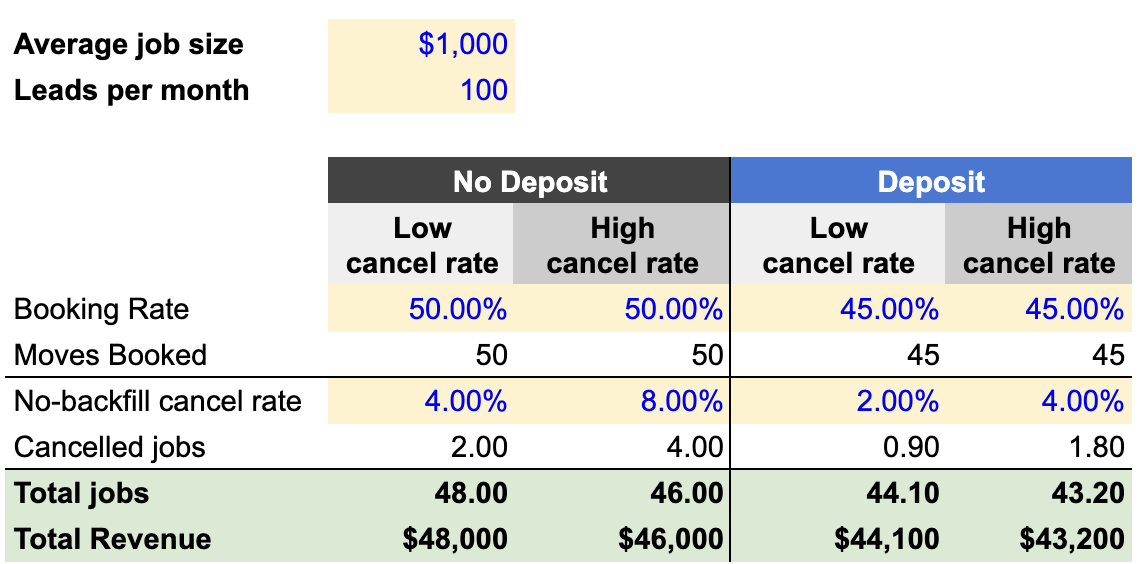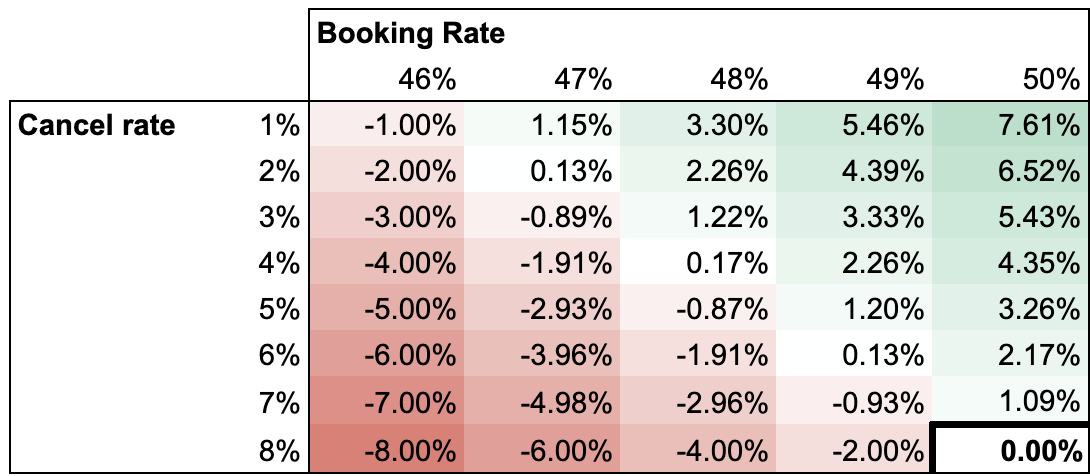%20(1).svg)
One of the most hotly debated topics in the moving industry: should you require a deposit to book a move?
A deposit can help reduce cancellations and no-shows, but it might also lower your booking rate and scare off potential customers. Among Chariot moving software customers, a slight majority of moving companies do charge a non-refundable deposit. Most send an estimate with an embedded deposit payment flow — once the customer signs, they’re prompted to pay.
If you’re a moving company unsure whether to charge a deposit — or how much — this post offers a simple analytical framework to help you decide, plus an interactive calculator to run the numbers for your own business.
✅ You should probably charge a deposit if:
❌ You should probably not charge a deposit if:
We also discuss below why charging deposits on bigger multi-truck and long-distance moves makes sense for most movers, even if you don't charge deposits on smaller local moves.
This is the biggest benefit — and the most intuitive. A customer who pays a deposit is more committed. If they cancel, they lose money. If they don’t pay, they may not be serious about booking. That’s a red flag.
Asking for a deposit acts like a soft credit check. If a customer can’t pay $100–$200 upfront, they may also be unreliable on move day.
If your CRM or processor supports it, taking a deposit means you have the card on file — which simplifies final payment and gives you recourse if they ghost you.
Every 1% increase in booking rate can increase your revenue by more than 1%. For example:
The same way, a 1% drop in booking rate can decrease your revenue by more than 1%.
With that in mind, a deposit adds friction to your sales process. Some customers won’t book and your booking rate could fall. Even if cancellations drop, that lost revenue may not be recouped, unless you're booking higher-revenue moves than you were before the change.
Without a CRM or integrated tool, deposits can become admin-heavy. Time is required to collect payments manually, track who paid, chase down cards, and ensure deposits are deducted from the final bill.
Some customers see deposits as a lack of trust or a red flag. If you don’t charge one, you can frame it as a benefit: low-pressure, easy booking!/
The revenue impact of charging a deposit is fundamentally:
[Increase in revenue from reduced non-backfilled cancellations] - [Revenue lost from a lower booking rate]
Remember: not all cancellations hurt you as badly as others. If you can backfill a canceled job, the lost revenue is recovered (though this requires more sales time, and that time is money too). That’s why we focus on non-backfilled cancellations in this analysis.
Let’s say:
If you charge a deposit:

Even with a significant drop in cancellations, the 5% dip in booking hurts more — resulting in $1,000–$2,000 less revenue per month.
So should you never charge deposits? Not so fast...
The example above shows that if your booking rate falls meaningfully, it can outweigh the revenue impact of fewer cancellations. But what if it falls by less than that?
Let's assume your current booking rate is 50% and non-backfilled cancellation rate is 8%. The image below shows the change in revenue based on how far the booking rate and cancellation rate falls.

If your current cancellation rate is high (e.g. 8%), and your booking rate only drops a little (e.g. from 50% to 48%), the deposit might still boost revenue.
General rule of thumb:
To break even on revenue, your cancellation rate must drop by at least 2x the amount your booking rate drops.
This ratio shifts if your booking rate is far from 50% (if it's lower, the cancellation rate needs to be even more than 2:1) — but 2:1 is a helpful starting point.
Want to test it for your company? Use the interactive calculator below. Plug in your own numbers for:
We'll show you how your total revenue changes.
You should charge a deposit if:
You should probably not charge a deposit if:
Depending on your moving company's customer base and job mix, charging deposits on certain types of moves but not others might be the best approach.
For example: some movers don't charge a deposit for smaller, local moves, but charge them on more expensive larger moves (for example involving multiple trucks) or long distance moves.
Using the framework above, why can this work?
Small/ local moves:
Bigger/ long-distance moves:
Most movers choose one of these:
The benefit of the non-flat approaches is that they scale with the customer/ move size. This is good, because bigger moves are harder to backfill if they cancel and more of a payment risk. But flat rate approaches have the benefit of simplicity.
As for the exact amount to charge, we don't have an exact recommendation, other than to make it meaningful -- at least $50. You need cancellations to drop for the deposit to be effective. So find the balance between creating real financial incentives not to cancel/ drop you for a competitor, without turning off customers.
If your competitors all charge deposits, you probably won’t lose bookings by doing the same. But if few do — and you’re using no-deposit booking as a differentiator — highlight that in your sales pitch.
And if you’re using Chariot, we make deposits seamless: estimates, e-signatures, and payments all in one flow.
Ready to experiment? Use the calculator and try it out!
Ready to move?